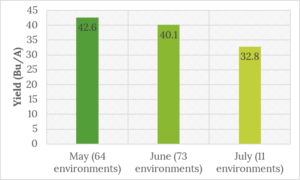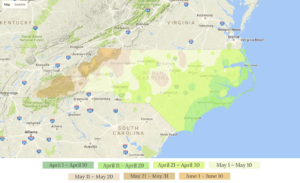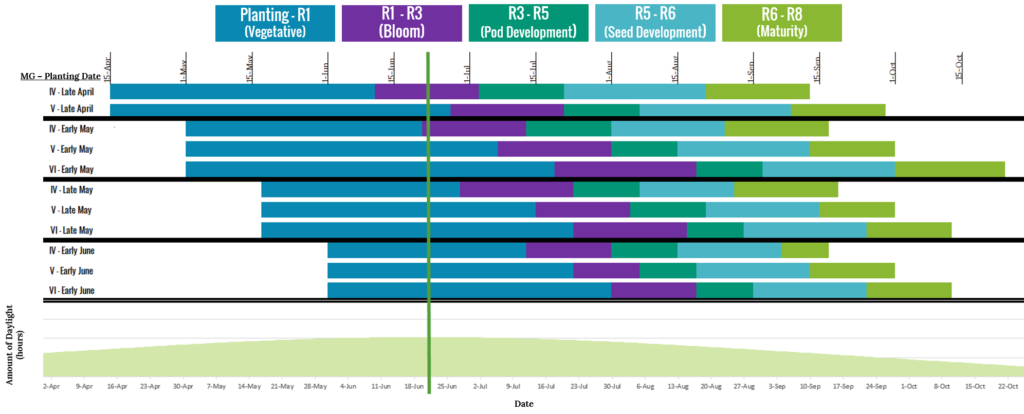This week we continue with our management decisions series. Last week we discussed seeding rate and how you may be able to save money by decreasing your seeding rates. If you missed it, catch up here.
In part two of our management decisions series, we’re talking planting date. Before we get into some data, it’s important to remember soybeans tolerate a wide range of planting dates, and one of the biggest things to factor into your planting date decision is the other crops in your operation. Planting dates in North Carolina are largely dependent on the harvest of the previous crop in the rotation and the production timelines of other crops on the farm. Ultimately, your planting date decisions should depend on what fits best in your operation.
When it comes to selecting a planting date, we all know that earlier planting dates are usually associated with higher yields and that on average May planted beans out yield June planted beans which out yield July planted beans.
But the question is how early can we plant and what maturity groups should we be planting at these early dates?
One way states in the Mid-South have increased soybean yields over the last 20 years is by moving to an Early Soybean Production System which is based on early planting (late March through mid-April) of early-maturing (MG IV – MG V) soybean varieties. This system has worked really well in states such as Mississippi and Arkansas. In Mississippi, this system has helped raised the average state yield from 21 bu/ac in the 1980’s to 47 bu/ac last year.
In North Carolina, planting soybeans in mid-March is pretty risky as our average last frost date is not until mid-April but there may be the potential to increase yield by planting IV’s or V’s in late April to early May. As you can see below, most of Eastern North Carolina is clear of frost by the end of April, so an early May planting could be a fairly safe bet.
One of the keys to growing soybeans is to maximize light interception. I’m sure you’ve all heard Dr. Dunphy’s famous line that we need to “get the plants big enough, quick enough to harvest enough light to maximize yields.” But how do we do that?
Well, our longest day occurs on the summer solstice, June 21. Agronomists that have worked with this Early Soybean Production System suggest having soybeans at R1 to R3 near the longest day of the year so they are capturing the greatest amount of light when it is needed the most – for setting and filling pods.
I compiled data on days to maturity from research carried out at North Carolina State University, USDA-ARS Stoneville, and the University of Arkansas to create the following graph. The graph has an “estimated” time between different growth stages for different maturity groups (IV, V, VI) at a range of planting dates (late April – early June). At the bottom, the number of hours of daylight for each day is shown in the light green arch. These intervals are only estimates and will vary some from year to year and environment to environment.
A couple assumptions went into compiling this graph.
- For any planting date, we expect it to take about 10 days longer to reach R1 as you move up in maturity group
- The time required for each of the reproductive growth stages is fairly consistent regardless of maturity group
- As you delay planting date, the time to reach R1 decreases for all maturity groups.
The green vertical line on the graph is at about June 21. If our goal is to get between R1 – R3 by June 21, really our best option in NC is a late April to early May planting of a group IV or early group V.
Now, I’m not suggesting you go and plant all your acres with a group IV in late April because there are many other factors to consider. One of the most important being will you have time to cut beans when they reach maturity? Most of the earlier maturing varieties will not hold long in the field and you must be ready to go when they are.
However, transitioning a portion of your acres to an earlier planting date may be something to consider. One advantage of this is risk mitigation. If you stagger planting dates you may miss drought, heavy rain events or hurricanes on one group that hit another. You also spread out your harvest window.
When making planting date decisions for your operation, it’s important to remember that this is not a one size fits all decision and what works well on one farm may not work on another. But if you think an early planting date may work on your operation, I would suggest you try it out on a small portion of your acres.
References:
Dunphy, E.J. 2014. NCSU Soybean Production Class.
Heatherly, L.G. 2005. Soybean Development in the Midsouthern USA Related to Date of Planting and Maturity Classification. Plant Management Network. http://www.mssoy.org/uploads/files/soy-dev-mg-dop-cm-2005.pdf.
Purcell, L.C., M. Salmeron, and L. Ashlock. 2014. Soybean Growth and Development. Arkansas Soybean Production Handbook. University of Arkansas Research & Extension. http://www.mssoy.org/uploads/files/soy-growth-dev-ark.pdf.









